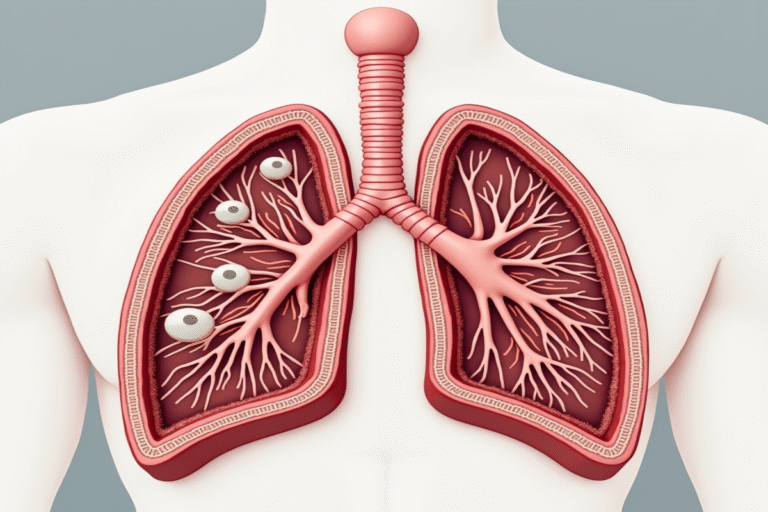Every minute of every day, you take around 12-16 breaths without giving it a second thought. But hidden within this automatic process is an extraordinary self-cleaning mechanism that helps keep you alive and healthy. Your respiratory system isn’t just exchanging oxygen and carbon dioxide—it’s actively defending you against a barrage of environmental threats.
The Respiratory System: A Marvel of Engineering
Your lungs are not simple air sacs. They are intricate structures with over 1,500 miles of airways and 300-500 million tiny air sacs called alveoli. If spread out, your lungs would cover an area about the size of a tennis court! But this vast surface area creates a challenge: it is constantly exposed to particles, microbes, and pollutants from the environment.
Evolution’s solution is a sophisticated self-cleaning mechanism that works with every breath you take.
The Mucociliary Escalator: Your Lungs’ Cleaning Crew
Lining your airways are billions of microscopic hair-like structures called cilia and specialized cells that produce mucus. Together, they form what scientists call the “mucociliary escalator”—one of the most effective cleaning systems in nature.
Here’s how it works:
- Mucus production: Special goblet cells secrete sticky mucus that traps inhaled particles—dust, bacteria, viruses, and pollutants.
- Ciliary movement: The billions of tiny cilia beat rhythmically at an astonishing 12-15 times per second, creating a wave-like motion.
- Continuous transport: This coordinated beating moves the mucus (and trapped particles) upward toward your throat, at a speed of roughly 1-2 cm per minute.
- Final elimination: Eventually, you either swallow this debris-laden mucus (where stomach acid neutralizes potential threats) or expel it by coughing or sneezing.
Surprising Facts About Your Lungs’ Self-Cleaning System
This microscopic cleaning crew handles an impressive workload. Your lungs process approximately 10,000 liters of air daily, filtering out:
- Up to 25 million particles per hour in urban environments
- Countless microorganisms, including potential pathogens
- Pollutants and irritants from both outdoor and indoor environments
Perhaps most remarkable is that this system works continuously without rest. The cilia keep beating even while you sleep, ensuring your airways remain clear day and night.
When the System Faces Challenges
Cigarette smoke is especially damaging—it can paralyze cilia for hours after exposure and with chronic use will eventually destroy them. This explains why smokers often develop the characteristic “smoker’s cough”—without properly functioning cilia, the body must rely on coughing to clear out accumulated mucus.
Respiratory infections can temporarily overwhelm or impair the system. When you have a cold or flu, your body often increases mucus production to trap more viruses, but this can overload the transport system, leading to congestion and coughing.
Genetic conditions like primary ciliary dyskinesia (PCD) affect about 1 in 15,000 people, causing immobile or ineffective cilia and leading to chronic respiratory problems.
Supporting Your Lungs’ Natural Cleaning Abilities
Recent research has revealed several ways to support this remarkable system:
- Proper hydration: Drinking enough water helps maintain the ideal mucus consistency for effective transport.
- Steam inhalation: Warm, moist air can temporarily enhance ciliary activity and mucus flow.
- Physical activity: Regular exercise improves lung function and can help clear mucus through deeper and faster breathing.
- Avoiding irritants: Minimizing exposure to pollution, smoke, and harsh chemicals protects your cilia from damage.
Cutting-Edge Research Insights
Scientists continue to study this self-cleaning system. Recent studies have found that cilia not only move mucus—they also sense their environment. They contain special receptors that detect irritants and can trigger increased mucus production or stimulate coughing when needed.
The rhythm of ciliary beating isn’t random. Researchers at Stanford University discovered that neighboring cilia coordinate their movement through fluid interactions, creating metachronal waves—a synchronized pattern similar to a crowd doing “the wave” in a stadium.
The mucociliary transport system also helps with immunity. Mucus contains antimicrobial proteins and antibodies that neutralize threats before they reach deeper lung tissue.
An Underappreciated Marvel
Each breath you take engages this microscopic cleaning team. If you have taken about 16 breaths while reading this article, your lungs have already filtered, trapped, and started to remove countless particles from the air you inhaled.
This elegant cleaning system is one of the many ways your body maintains itself without you ever noticing. It is a testament to the remarkable design solutions evolution has produced over millions of years—a microscopic marvel at work inside you with every breath.





